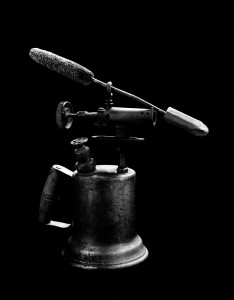page 10 of 20
 There were certain farm tools that I recall most of us having in the ‘50’s and 60’s, just a dozen or two, but they were ubiquitous. Some were outmoded by then, mere artifacts, of little interest to me beyond their eccentric shapes. Included in this category were ice tongs and picks, from the days when houses had iceboxes. There was usually a bronze blow torch, once used to thaw pipes, solder tin and warm the oil pans of flivvers. There were flimsy milk-cow hobbles, which only work because cows kick outward, with little momentum. Horses kick back, which is a useful distinction: walk behind a cow, not a horse. There were always a couple of horn weights on a shelf, to train a cow’s horns downward and take the bully out of her at the bunk. There were bird-like fencing pliers with staple-pulling beaks. There were sheep shears and draw knives and V-shaped magnets from Model T magnetos. There were sheet-metal calf weaners, for when a cow allowed last year’s calf to compete at the teat with this year’s calf. These contraptions were strapped to the yearling’s nose and featured a row of sharp teeth, which came to bear each time he nudged for milk.
There were certain farm tools that I recall most of us having in the ‘50’s and 60’s, just a dozen or two, but they were ubiquitous. Some were outmoded by then, mere artifacts, of little interest to me beyond their eccentric shapes. Included in this category were ice tongs and picks, from the days when houses had iceboxes. There was usually a bronze blow torch, once used to thaw pipes, solder tin and warm the oil pans of flivvers. There were flimsy milk-cow hobbles, which only work because cows kick outward, with little momentum. Horses kick back, which is a useful distinction: walk behind a cow, not a horse. There were always a couple of horn weights on a shelf, to train a cow’s horns downward and take the bully out of her at the bunk. There were bird-like fencing pliers with staple-pulling beaks. There were sheep shears and draw knives and V-shaped magnets from Model T magnetos. There were sheet-metal calf weaners, for when a cow allowed last year’s calf to compete at the teat with this year’s calf. These contraptions were strapped to the yearling’s nose and featured a row of sharp teeth, which came to bear each time he nudged for milk.
 Some models were designed to stab the cow, while others were meant to stab the calf. It all depended on where you came down on the issue of blame. Hammers and saws and hoof trimmers abounded. These hammers showed evidence of broken handles, which had been shortened, shaved and reaffixed, often several times. You can save a buck this way, if you don’t mind the short swing; don’t mind wearing out your wrist. Flypaper hung in milk parlors and workspaces, and if you paid very close attention, you could hear furious little dramas unfold. A stuck fly will immediately wind its wings to a buzzing crescendo, then slowly trail off, dissipated, like a crop duster heading home. Flypaper is a tool of sorts, an instrument, like a bushel basket or a clothespin.
Some models were designed to stab the cow, while others were meant to stab the calf. It all depended on where you came down on the issue of blame. Hammers and saws and hoof trimmers abounded. These hammers showed evidence of broken handles, which had been shortened, shaved and reaffixed, often several times. You can save a buck this way, if you don’t mind the short swing; don’t mind wearing out your wrist. Flypaper hung in milk parlors and workspaces, and if you paid very close attention, you could hear furious little dramas unfold. A stuck fly will immediately wind its wings to a buzzing crescendo, then slowly trail off, dissipated, like a crop duster heading home. Flypaper is a tool of sorts, an instrument, like a bushel basket or a clothespin.
